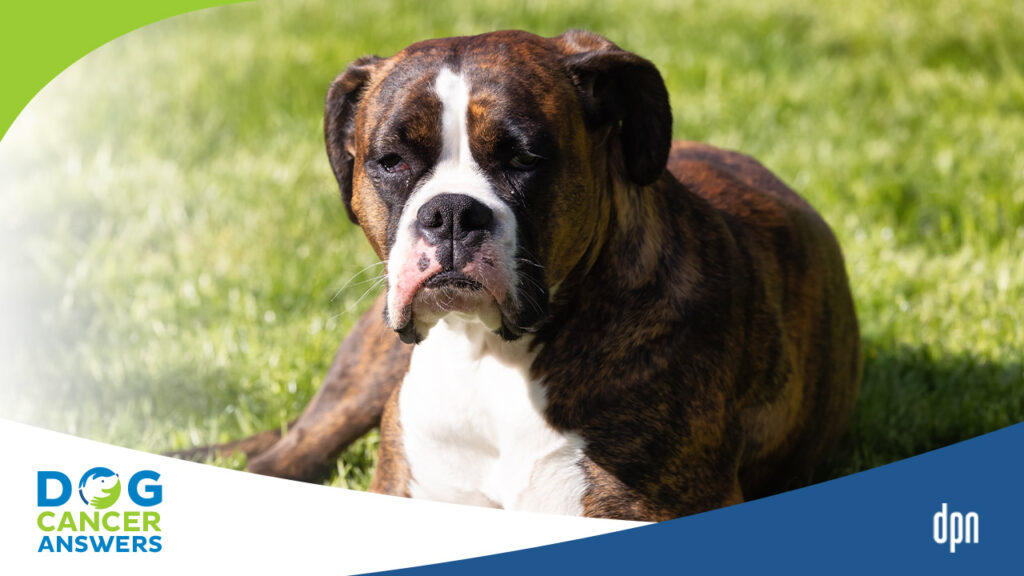EPISODE 242 | RELEASED April 1, 2024
Alternative to Chemotherapy for Dogs with Osteosarcoma | Tammie Wahaus of ELIAS Animal Health
Why isn’t there an alternative to chemotherapy for dogs with cancer like osteosarcoma? Regulation! Let’s nerd out on the regulatory process with a biotech entrepreneur.
SHOW NOTES
ELIAS Animal Health CEO Tammie Wahaus returns to Dog Cancer Answers to talk about the company’s immunotherapy for dogs with osteosarcoma, which recently cleared an important milestone on the way to market.
ELIAS hopes their treatment will be accepted and used as a safe and appropriate alternative to chemotherapy in dogs with osteosarcoma. Instead of using chemotherapy to control metastasis, ELIAS uses the dog’s tumor to create a series of vaccines. Once the dog has the vaccinations, their immune system cells are harvested, taken back to the ELIAS labs, and spun up into an “army of angry killer T-cells” that are ready to murder that specific tumor!
It’s truly personalized medicine and the first of its kind in animals OR people. Join us as we follow ELIAS progress on the way to market.
ELIAS Animal Health’s website: https://eliasanimalhealth.com/
>> James Jacobson: [00:00:00] Why do our dogs still face old school treatments for cancer? We’re uncovering new paths in veterinary medicine that challenge the status quo. Today, we’re speaking to a biotech entrepreneur about their potential alternatives to chemotherapy for dogs with osteosarcoma.
>> Announcer: Welcome to Dog Cancer Answers, where we help you help your dog with cancer.
>> James Jacobson: Hello friend, I’m James Jacobson, founder of Dog Podcast Network. Welcome to Dog Cancer Answers. This is the official podcast of DogCancer.com. Start your research at DogCancer.com because our promise is better information today, so you have no regrets tomorrow.
Today we’re exploring an innovative immunotherapy with Tammie Wahaus from ELIAS Animal Health. It’s for dogs with osteosarcoma and has just cleared a major milestone on the path. to market. [00:01:00] The journey towards market acceptance is not straightforward. We’ll discuss with her the company’s novel approach and how it differs from traditional methods.
Now, I need to flag something right up here up front. We’re discussing something called a biologic technology, which is a treatment made from living cells. and it’s not a conventional drug. This means that ELIAS is navigating a different regulatory landscape. Why does that matter to you? This immunotherapy’s regulation is under the purview of the USDA, the United States Department of Agriculture, rather than the FDA, the Food and Drug Administration.
The USDA route can be quicker, and potentially that streamlines the path to bringing this personalized treatment to the market to our dogs sooner. ELIAS’ method is compelling. They start by making a vaccine derived from the dog’s own tumor. After a series of [00:02:00] vaccinations, the dog’s own immune system knows how to fight that tumor.
However, it is not strong enough to actually beat the cancer. So that is when ELIAS takes the naive immune cells back to their facilities and whips them up into a veritable army of angry T-cells. And now that army of angry T-cells becomes an immunotherapy infusion. That infusion is administered to the dog, and this personalized cancer treatment represents a hopeful shift towards targeted cancer therapies.
Will it prove a safe and effective alternative to chemotherapies for dogs with osteosarcoma? ELIAS hopes so, and not just for osteosarcoma, but maybe for other cancers as well. But, as is so often said here on Dog Cancer Answers, we’ll know more when we know more later down the road. But the road to innovation is paved with challenges.
CEO Tammie [00:03:00] Wahaus first came to Dog Cancer Answers back in 2022. Today, we are continuing that with a new conversation and an update. We’ll cover the results of the clinical trials, the successes, and the obstacles encountered, and what is next for this pioneering treatment as it proceeds to full market approval.
And now let’s go to our conversation with Tammie Wahaus of ELIAS to learn more about their progress, the lessons learned, and their potential impact on veterinary oncology’s future.
Tammie Wahaus, thank you so much for being with us today.
>> Tammie Wahaus: Thank you. It’s a pleasure to, to be back on the podcast and share updates from ELIAS.
>> James Jacobson: Yes, we had you back in early 2022, so a bit has changed. I know you got some news from the U. S. Department of Agriculture recently that helps advance what you’re doing. Tell us about that.
>> Tammie Wahaus: Yeah, so when we last spoke, I think we were wrapping up our clinical trial, our pivotal study for bone [00:04:00] cancer in dogs.
Most recently, in January, we received notification from the USDA that they found our study results acceptable for purposes of moving forward in the licensure process. So that’s been the hill we’ve been climbing since we, you know, launched this company and it’s exciting to finally be here. Still a lot of work ahead of us.
We are working on the commercialization plan for how we will launch the product commercially. In the meantime, it will continue to be available under the experimental label that we’ve been operating under for the last several years. But we’re at the stage with the regulatory body that, you know, we’re working on what information will the labels contain.
And all of that takes a little bit of time and it’ll be later in 2024 when we get the official license and switch over to, you know, a [00:05:00] licensed product, the product itself won’t change. It’ll just be a different label.
>> James Jacobson: It’ll just be a different label because they determined that it has, I think, quote unquote, reasonable efficacy. It’s reasonable to expect that there might be efficacy in this, which is the guarded language that all these regulatory bodies use, right?
>> Tammie Wahaus: That’s right. That’s right. And that’s even an evolutionary process. You know, the autologous therapies and, and specifically the autologous cell therapy that we’re using is, you know, first in the category. So there’s a lot of things that are being learned by us, by the regulator, as everyone kind of steps through this process. And so for the autologous products, their label will say, you know, that it has demonstrated a reasonable expectation of efficacy. It has also demonstrated an acceptable safety profile.
It’ll say what we found in the study, what was the efficacy and what’s the safety profile look like? What things, you know, could you expect to occur? [00:06:00] You know, it’s, it’s exciting and challenging to be first because there’s a lot of unknowns.
>> James Jacobson: ‘Cause you are first. Let’s talk a little bit about that. For those who might not have heard our last podcast from a couple years ago because they weren’t focusing on dog cancer at that point because, well, it just wasn’t relevant in their lives. Kind of, you know, do the quick survey overview of what this might technology is that you’re using?
>> Tammie Wahaus: Yeah, sure. So from a scientific perspective, it’s called an adoptive cell therapy. We use the word autologous and I can explain that very simply by saying autologous means that you have taken cells from one individual, you’ve processed them and you’re giving them back to that same individual.
So, you know, ours is a personalized medicine in the sense that we’re collecting the tumor tissue from the surgeons so that we can turn those into a vaccine that is used to inform the immune system what the cancer looks like. And [00:07:00] following the vaccine series, we’re going to end up with T-cells, which are the immune cells in the body now recognize what the cancer looks like.
Unfortunately, they’re not strong enough yet to really fight the cancer. So we’re going to then collect those primed immune cells and process them in our lab, in our manufacturing facility, into killer T-cells. So you’re going to give us prime T-cells after you get the vaccinations, and then we’re going to give you back killer T-cells that are now activated and expanded in numbers. So there’s a lot of them and they’re really mad about that cancer.
>> James Jacobson: And so that’s really the way to describe the difference between a prime T-cell and a killer T-cell.
>> Tammie Wahaus: Yeah, yeah. And, you know, it is an actual technical term, killer T-cells.
>> James Jacobson: But it’s one of those rare times where the term actually conveys to everyone, even a layperson.
>> Tammie Wahaus: Yeah, and you know, their [00:08:00] job, and again, to maybe explain it, you know, in a non scientific way, the immune cells, these T-cells that we all have, their job in the body is to constantly surveil and look for things that don’t belong here. So their job is to, you know, find bacteria, kill it, find viruses, kill it. Find cancer, would like to kill it, but mutation of yourself. And the immune cells, the T-cells have a mechanism, you know, unless you have autoimmune disease, they don’t want to kill themselves.
>> James Jacobson: Right.
>> Tammie Wahaus: Right? They don’t want to kill the host. They want to just keep looking for things that don’t belong here. So cancer has a whole lot of mechanisms that enable it to hide from the T-cells. And so it takes this ex vivo, outside the body activation so that the T-cells can come back in in large numbers, you know, like an army with the tools. that are [00:09:00] needed to cause the cancer cells to die.
Now, the tools that they have is essentially, you know, they just go around the body and probe cells that they come across. And when they find a cell that has this abnormality, they essentially, you know, poke a hole, cause it to die.
>> James Jacobson: Yeah, you get out of here.
>> Tammie Wahaus: Yeah, they do it through some proteins that are called cytokines, which is what aids in the killing of the cancer cells.
>> James Jacobson: So the study that the USDA said had a reasonable expectation of seeing some efficacy, you had 100 dogs in it?
>> Tammie Wahaus: Yeah, we had approximately a hundred dogs. We screened about 120 and, you know, there’s always in a clinical trial some dogs who don’t qualify. So we had about a hundred dogs, and they were randomized one to one, which means when they came into the study, if they met all the criteria for participation in the study, they would get randomly assigned to [00:10:00] either our treatment arm or the control arm.
And in this particular case, the control arm was what is commonly used today to treat canine osteosarcoma, which is a form of chemotherapy called carboplatin. So all dogs were received some form of therapy either what is commercially available today and has been for the last.
>> James Jacobson: Standard of care. What is the standard of care?
>> Tammie Wahaus: Standard of care for the last 40 years, or the experimental therapy which was our treatment.
>> James Jacobson: And the results in that early trial?
>> Tammie Wahaus: So the results from the pivotal study where the USDA found that it had a reasonable expectation of efficacy, we were able to demonstrate that a certain percentage of dogs were able to derive a benefit from our therapy.
And keep in mind that these dogs were treated with our therapy instead of chemo and not in addition to chemo. [00:11:00] So what we were hoping to prove is that our therapy is an appropriate alternative to chemotherapy because you have a lot of pet owners out there that either won’t choose chemotherapy for their dog.
>> James Jacobson: Right.
>> Tammie Wahaus: Or for a variety reasons can’t choose chemotherapy for their dog.
>> James Jacobson: So reading between the lines in terms of the efficacy relative to the traditional carboplatin, it was as good, not quite as good.
>> Tammie Wahaus: Yeah, so I would say we were not quite as good as the carboplatin in our study. I will say that the carboplatin results in our study outperformed any other carboplatin study ever performed.
>> James Jacobson: Yeah.
>> Tammie Wahaus: So, you know, from our perspective.
>> James Jacobson: Unfortunately that ain’t for the case.
>> Tammie Wahaus: Right, right? You know, so like.
>> James Jacobson: The way science works, yeah.
>> Tammie Wahaus: Yeah, it’s exactly. Yeah. We had to run the study during the pandemic. We had for whatever reason, the carboplatin treatment arm just [00:12:00] magnificently outperformed.
>> James Jacobson: By a factor of?
>> Tammie Wahaus: Yeah, normally one would expect a median survival time of, with carboplatin, all the historical studies say somewhere between 270 days. 320 days. Our carboplatin arm was way beyond 320 days. But if you compare ours to, you know, what we have seen historically and what people normally expect carboplatin to do, we were right in there with, you know, what we’ve historically seen carboplatin to do.
So disappointing to, you know, have that happen in the study. Also disappointing that we had to run the study during the pandemic. So, but, you know, despite the odds, you know, we’re pleased to be able to say that this continues to be a treatment option that is viable. And we’re monitoring safety all the time, right?
But we had very few adverse events. In that trial, we had no serious adverse events that were triggered by the treatment. [00:13:00] I mean, these dogs have cancer and bad things happen to dogs with cancer. But in that trial, we saw no serious adverse events that were treatment related or treatment emergent would be a different way to say it.
So we were very pleased that the safety profile in the big study was very consistent with the safety profile in the first preliminary study. And, you know, we do know that with cell therapies, especially adoptive T-cell therapies, that you can have a serious adverse event that’s called cytokine release syndrome.
So anybody who’s out there like Googling, you know, what happens, what are the side effects from CAR Ts or side effects from, you know, on the humans, they are seeing the cytokine release syndrome. And so we watch for that, and we educate the veterinarians based on everything we’ve seen. What should you be watching for that will suggest to you [00:14:00] that this might be happening in this particular dog because everyone’s immune system is different. They’re gonna react differently. We fortunately did not see it in the big study.
>> James Jacobson: So none of the hundred dogs or 50 or whatever.
>> Tammie Wahaus: None of the 50 dogs had that.
>> James Jacobson: Yeah.
>> Tammie Wahaus: But we don’t want to be complacent, right?
>> James Jacobson: Because you had seen some of it in the prior study.
>> Tammie Wahaus: We saw one case of it in the prior study. We’ve seen a few potential cases of it in like other tumor types. And so we want to make sure everybody’s got their eyes wide open and they know what to watch for, and when it’s happening. How to treat it quickly because you can reverse it, but you have to be paying attention. So, you know, in all of our training and all of our educational material, we make sure that everyone knows that this is a possibility.
We don’t see it very often. But until you do thousands and thousands and thousands of dogs, you can’t say it’s rare.
>> James Jacobson: Right. And the vets you’re working with, are they all oncologists?
>> Tammie Wahaus: [00:15:00] Right now, we are working primarily with veterinarians who specialize in oncology.
>> James Jacobson: But not necessarily boarded oncologists, but folks who, who specialize.
>> Tammie Wahaus: Yeah, because the board certified oncology certification, you still have a lot of, very experienced oncology specialists that were oncology specialists before that certification was a thing. And so, you know, they tend to be board certified internal medicine, but for the T-cell infusion, we want the T-cell infusions done in a hospital where there is emergency care or overnight care, because if a dog does have an issue, we don’t want them to have to be transported somewhere to spend the night.
We want them to be in a hospital that has the capabilities to handle it. That won’t always be the case, but as we, you know, as we get to thousands and thousands of dogs, maybe there’s a profile of dog that we can say if the dog has this profile, then he should be treated in a facility with emergency care or overnight.
>> James Jacobson: And this is at the [00:16:00] stage where you introduce the killer T-cell.
>> Tammie Wahaus: Yeah.
>> James Jacobson: Which is a longer process, it’s not just an injection.
>> Tammie Wahaus: Yeah, it’s actually just a 30 minute infusion.
>> James Jacobson: Okay.
>> Tammie Wahaus: But, you know, anytime you’re infusing anything into the blood stream, you know, they could have just a simple infusion reaction that isn’t a cytokine release syndrome, but they’re having an infusion reaction. Again, we didn’t see it in the big study. We saw it very infrequently among, you know, all of the other dogs we’ve treated, but again, we don’t want to be complacent. And so we’re right now going to continue to work with the hospitals that have the overnight care capabilities.
>> James Jacobson: Okay. Let’s pause here and acknowledge you. If you’re watching this, your dog may have cancer and you are searching for solid information on new treatments. Well, congratulations! You are not alone. You’re one of the compassionate and smart dog lovers that we love to help at DogCancer.com. [00:17:00] DogCancer.com is your trusted ally in navigating your dog’s cancer journey.
With our expert, vetted, and easy to understand resources, you can get better information today, so you have no regrets tomorrow. Providing accurate and comprehensive medical information is our number one priority. But beyond that, we offer hope.
Our team is amazing. It includes dozens of veterinarians and veterinary oncologists, and technicians and PhD cancer researchers and science writers. That brain trust that we have all research, write, and perform rigorous medical review on every single resource at DogCancer.com. All of them, all of us, love dogs as much as you do. And we really understand on an emotional level what you are going through.
At a recent meeting, a veterinarian colleague team member said something like, [00:18:00] you know, telling clients, quote, there’s nothing that we can do is just not cutting it anymore. Everyone on our team agrees with that sentiment. Don’t wait to get the support and information that you need. Visit DogCancer.com today, and join a community that understands and cares.
And now, let’s continue our hopeful heart to heart with Tammie Wahaus about an experimental immunotherapy for dogs.
Right now, you’re only focusing on osteosarcoma, right?
>> Tammie Wahaus: That was our primary target, yes. And so, we’ll, assuming everything stays on track, you know, we would be the first cancer therapeutic approved for for bone cancer in dogs. And one of the unique features of our product is that, because we’re leveraging the tumor cells and leveraging the immune system, there’s very good [00:19:00] possibilities for this product to work in other cancer types. We had to stay focused on one cancer type because that’s how you have to present your material for regulatory approval.
So, as we’re working on what our next steps are, we will continue to pay attention to lymphoma and see if we can figure out how to crack that nut.
>> James Jacobson: Would that be the next one that you do after osteosarcoma?
>> Tammie Wahaus: So the very next trial that we’re going to do is to try to work in metastatic osteosarcoma, because our first trial was done in dogs where they were not metastatic at diagnosis. So that was one of their criteria.
>> James Jacobson: Meaning it was discreet, it wasn’t metastasizing around the body.
>> Tammie Wahaus: It wasn’t visibly metastasized.
>> James Jacobson: Right.
>> Tammie Wahaus: But with osteosarcoma, what they know, you know, and what history tells us, is that It most likely has metastasized, it’s just micrometastases and we can’t see them yet [00:20:00] on radiographs. But that was the criteria. If you had full on lung mets that could be detected with radiographs, then you were not eligible for that trial because you were too much different. And, you know, in order to get that reasonable expectation of efficacy, you’ve got to have patient population that is sufficiently similar in stage of disease that you can reach a conclusion on does it work in this population of dogs?
So now what we’re going to be doing is looking at that population of dogs that have metastatic disease. So they’ve got lung mets at diagnosis. So it’ll be a small study enrolling at least 10 dogs where we’re putting our T-cell therapy in combination with a checkpoint inhibitor. So the hypothesis is, what if you put two immunotherapies in? One working this way.
>> James Jacobson: Contemporaneously.
>> Tammie Wahaus: Yes, or integrated in some way, not necessarily [00:21:00] on the same day. But what if we attack the metastatic disease with a checkpoint inhibitor while we’re bringing the adoptive self therapy on board and have that integrated, can the one immunotherapy slow that metastatic disease down long enough for the T-cell therapy to fully ramp up the immune system?
>> James Jacobson: So while you’re looking at, you know, potentially different combinations of treatments using two different Immunotherapies, had you looked at you know using this in conjunction with, say carboplatin, so like you would be doing both at the same time for a higher efficacy?
>> Tammie Wahaus: Yeah. So we are working with a number of, uh, veterinary oncologists who believe very strongly that one or two doses of carboplatin right up front might provide a boost to the T-cell therapy as well. [00:22:00] So we actually are writing up kind of a blog, I guess, that we’ll make available to the veterinary oncologists to kind of pull together what we have seen as various people are doing this.
Are they doing one dose? Are they doing two doses? And we’re actually following dogs that what we call our non-clinical trial dogs. So these are the dogs that, you know, weren’t in the clinical trial, but they were on the treatment through the experimental label and we’re following those dogs as best we can so that we can evaluate, you know, does that make sense?
>> James Jacobson: Some oncologists are doing that.
>> Tammie Wahaus: Yeah, some oncologists are doing that right now.
>> James Jacobson: They’re using the 40-year-old carboplatin and then throwing immunotherapy on top of it.
>> Tammie Wahaus: Yeah, if you ask us we would say we would not suggest that you do all four doses of carboplatin, because by that time you maybe have changed so many things that you know, you aren’t helping. And during that time, you know, you’re damaging the immune system [00:23:00] with the chemotherapy. So, I think what they’re really looking for is, can we use the chemotherapy in one or two doses?
>> James Jacobson: Use less of it, a quarter or half.
>> Tammie Wahaus: Use less of it, yeah. And then bring on the adoptive cell therapy, which, you know, has a, an attractive safety profile and has demonstrated a reasonable expectation of efficacy. You know, we, we want to continue to look at, just like, you know, other drug developers, you have a population of patients who respond really well, and you have a population of patients that respond okay. And then you’ve got this third population, right, that didn’t respond at all.
And so the next question that you want to answer is, can we find out anything about the population that did well? What’s unique about them compared to the ones who didn’t do well? You know, are they breeds? Do they have some biomarkers? So that’s some of the work that, you [00:24:00] know, we’ll be taking on in the coming months and years is trying to isolate what are the predictive factors. Which dog, because if you are the dog who is going to do great on the T-cell therapy without carboplatin, let’s don’t have him take carboplatin.
But if you’re in that middle group where, man, if you’d had a dose of carboplatin, you would have been a great responder, then you want that dose of carboplatin. So there’s a good amount of analysis that can be done as we continue to work with the veterinary oncology community and treat patients to try to understand, are there any predictive factors that will help the oncologist make a treatment recommendation that is best suited for that particular patient.
>> James Jacobson: Okay, let’s take a quick break and hear a word from our sponsors. And then, Tammie, I want to ask you about where we are on the human side with this customized immunotherapy technology.
And [00:25:00] we are back with Tammie Wahaus of ELIAS Animal Health, whose experimental immunotherapy is poised to become the first technology of its kind in medicine for any species.
Let me ask you, how far ahead or behind are you with immunotherapy compared to what’s happening in the human space?
>> Tammie Wahaus: So, the T-cell therapy that we’re utilizing is also being advanced for use in humans and they’re just launching their phase 2, the registration trial. We’re going to beat them.
>> James Jacobson: And that’s done under FDA.
>> Tammie Wahaus: That’s done under FDA.
>> James Jacobson: And we should maybe make this very clear. So the reason that you’re able to do this through the U. S. Department of Agriculture as opposed to the Food and Drug Administration Center for Veterinary Medicine is?
>> Tammie Wahaus: The FDA has two divisions: a drug division and a biologics division for humans. The Center for Veterinary Medicine is drugs and the [00:26:00] USDA has biologics. They have the Center for Veterinary Biologics.
>> James Jacobson: Oh, okay.
>> Tammie Wahaus: Yeah. And so there’s a whole decision tree on what is your product and which regulatory body has jurisdiction over that. So, yeah.
>> James Jacobson: Okay. So they decided that.
>> Tammie Wahaus: Yeah. When we asked, they came back and said, this is a USDA Center for Veterinary Medicine product.
>> James Jacobson: Okay, so is immunotherapy not covered on the FDA side in the veterinary biologics part of FDA?
>> Tammie Wahaus: It’s not about whether it’s an immunotherapy because an immunotherapy is a technology that acts on the immune system. It’s more about is it a biologic? Is the underlying product a biologic.
>> James Jacobson: Well, define a biologic.
>> Tammie Wahaus: So it’s made of living cells.
>> James Jacobson: Okay.
>> Tammie Wahaus: Or is it a drug? It’s a, you know, much more about how is the product manufactured and what is the essence of the product, [00:27:00] and not as much about how does it deliver, how does it act?
>> James Jacobson: But in terms of this search for immunotherapy in general for cancer, and we’ll talk from a One Health perspective for a moment.
>> Tammie Wahaus: Yeah, sure.
>> James Jacobson: Which I think you guys obviously are looking at the long game, right? You’re obviously looking that if this can work in dogs, this can be transferred to people. So, in terms of the discussions with, about immunotherapy, In the human space, you guys are a little bit ahead or behind or how do you guys like do you look at it in this giant context of like understanding how we’re trying to get a hold on cancer through this very innovative approach?
>> Tammie Wahaus: Yeah. So for this particular technology, we’re a little bit ahead of where it is on the human side because we’ve completed our pivotal study, our registration study, and are on the pathway to licensure, and they’re just starting theirs. So from a, like a bigger picture of immunotherapy, it [00:28:00] really depends on the product and whether or not the product started in animals and moved to humans, or it started in humans and is being translated to animals?
So, you can find examples of ones where, you know, it’s fully approved in humans and has been for years and is only now coming to the companion animal side. So, it’s really all over the board.
We’re fortunate to be involved in the One Health space where, you know, that our target patients for right now, which are dogs, you know, do have enough similarities genetically to humans that we can look at what good things and bad things are happening in cancer product development on the human side and translate that to how do we interpret that for dogs.
But we also, you know, as a collaborator with the human health companies that we’re working with, for example, we’ve got, we’ve been licensed in another immunotherapy that is called an [00:29:00] oncolytic virotherapy. And right now that human product is further along than where we are in dogs. They’re already in their phase three trial and we haven’t even started.
So it’s really just product by product where you are, but we’re really excited about, you know, we’ve stayed laser focused on getting the T-cell therapy through this process and toward licensure. And we’re very excited about being able to then get laser focused from an R and D perspective on bringing this oncolytic virotherapy forward because that has the capability.
So, back to the combination of therapies, we would be able to combine this oncolytic virotherapy with our T-cell therapy and boost the number of responders.
>> James Jacobson: Across the board, it would, in theory, improve the result that you would see from.
>> Tammie Wahaus: Either product alone.
>> James Jacobson: Right. So there’d be some synergies there.
>> Tammie Wahaus: Yes, absolutely. We’re able to work across multiple cancer types and we plan [00:30:00] to. That product can work with our therapy, can work across multiple cancer types, can work with other therapies, and is, you know, fairly easy to administer. The unique feature of that one is, as compared to the other ones that are out there, is its safety profile enables you to dose it intravenously.
And most of those oncolytic virotherapies have a safety profile that limits you to only being able to administer it directly into the tumor or into the, you know, the peritoneal cavity, but not into the bloodstream. Why is that important? Well.
>> James Jacobson: That was my question. And why do you prefer the IV approach?
>> Tammie Wahaus: Because if you’ve got a dog with metastatic disease, you could dose this in the bloodstream, and the bloodstream will carry it to the metastatic sites instead of you having to administer it into all of the sites. [00:31:00] Sometimes dogs have, you know, inoperable tumors. So you don’t want to have to try to figure out how am I going to get this into the tumor if I can’t even, you know, surgically remove it. And dogs are small, right?
>> James Jacobson: Right.
>> Tammie Wahaus: Being able to dose it intravenously is, is really good. Particularly for the canine population.
>> James Jacobson: So, as you look to the future, you’re waiting for the USDA to do the label.
>> Tammie Wahaus: Yep.
>> James Jacobson: And then make it commercially available.
>> Tammie Wahaus: Yep, and then we’ll do an exciting commercial launch, switch over from our experimental label to a licensed product.
>> James Jacobson: And when do you expect that? This year?
>> Tammie Wahaus: Yeah, it’ll be later in ’24.
>> James Jacobson: And then contemporaneous with that, you, the CEO, you’re, you’re raising an A round of 10 million dollars?
>> Tammie Wahaus: Yes. Yes. We’re a 10 million dollar Series A.
>> James Jacobson: Yeah. Okay.
>> Tammie Wahaus: To fund the commercial launch, as well as fund the clinical development plans for the oncolytic virotherapy, as well as other, you know, pilot studies that [00:32:00] we’ll be doing to expand the application of this T-cell therapy into other cancer types.
>> James Jacobson: So we are going to continue to track your progress because this is fascinating and, you know, clearly there’s a lot that you’ve already done, but there’s a lot more to be done towards using this as a readily available tool for dogs with osteosarcoma. And then hopefully lymphoma and everything else.
>> Tammie Wahaus: Yeah.
>> James Jacobson: So Tammie, thank you so much for being with us today. We appreciate it.
>> Tammie Wahaus: You bet. And thank you for taking the time.
>> James Jacobson: And thank you, listener, for joining us today. I hope you find the sometimes slow, sometimes agonizing up and down process of bringing a new technology to market as interesting as I do. I kind of geek out on it. I look forward to visiting with Tammie Wahaus in the future to see how the commercial use of their technology works out as it gets wider acceptance.
Don’t forget to subscribe to this podcast wherever you listen and check the [00:33:00] show notes for links to our previous conversation with Tammie Wahaus and other related articles. You can also follow us on social media.
I’m James Jacobson. On behalf of all of us at Dog Podcast Network, I’d like to wish you and your dog a very warm, Aloha.
>> Announcer: Thank you for listening to Dog Cancer Answers. If you’d like to connect, please visit our website at DogCancer.com or call our listener line at (808) 868-3200. And here’s a friendly reminder that you probably already know, this podcast is provided for informational and educational purposes only. It’s not meant to take the place of the advice you receive from your dog’s veterinarian.
Only veterinarians who examine your dog can give you veterinary advice or diagnose your dog’s medical condition. Your reliance on the information you hear on this podcast is solely at your own risk. If your dog has a specific health problem, contact your veterinarian. Also, please keep in mind that veterinary information can [00:34:00] change rapidly, therefore, some information may be out of date.
Dog Cancer Answers is a presentation of Maui Media in association with Dog Podcast Network.
Hosted By
SUBSCRIBE ON YOUR FAVORITE PLATFORM
Topics
Editor's Picks
CATEGORY











